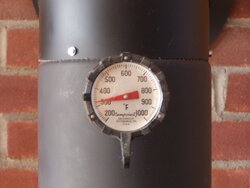I suppose most folks drive cars with automatic transmissions these days, but I drive a stick. Cars with manual transmissions like mine have a device, called a tachometer, that displays the rpm of the engine. The tach has a "red zone" at the high end that tells the driver it is time to shift to a higher gear, lest he or she causes damage to the engine. Driving in the "red zone" for extended periods of time can result in a cracked block.
Cars with automatic transmissions are designed to NEVER LINGER IN THE RED ZONE, so they usually don't have tachometers.
Wood stoves don't have tachometers either. The problem is, wood stoves can't automatically "shift gears" to a lower draft setting when the red zone looms. The only cues for the driver of a wood stove are what can be seen through the viewing window, and the temperature of the fire.
If you have an EPA approved stove, and both the primary and secondary flames are raging at the same time, you're in or near the red zone, and it's time to adjust the draft control to a lower setting.
If you have a stovetop thermometer and the temperature in the center of the top plate, just in front of the flue collar, is rising into the 600-650 degree range, it is time to adjust your draft control to a lower setting.
Wood stoves react slowly to draft adjustments, so when you "shift gears" at 650, your stove will likely peak in the 700-800 degree range, as my stove frequently does. But today's stoves are designed to withstand that brief and occasional foray, and will soon settle down to a more reasonable temperature.
The bottom line: if you chose a wood stove that is too small, or if your climate and/or house insulation (or a myriad of other factors) creates that you need to drive your wood stove in the red zone for extended periods, you're going to eventually crack your block. There are a couple of ongoing "cracked stove" threads in this forum wherein the poster has indicated that the stove in question has been systematically overfired. If anyone is interested (Sisu? Wxman? Hogwildz?), I'll be happy to post specific examples.
Cars with automatic transmissions are designed to NEVER LINGER IN THE RED ZONE, so they usually don't have tachometers.
Wood stoves don't have tachometers either. The problem is, wood stoves can't automatically "shift gears" to a lower draft setting when the red zone looms. The only cues for the driver of a wood stove are what can be seen through the viewing window, and the temperature of the fire.
If you have an EPA approved stove, and both the primary and secondary flames are raging at the same time, you're in or near the red zone, and it's time to adjust the draft control to a lower setting.
If you have a stovetop thermometer and the temperature in the center of the top plate, just in front of the flue collar, is rising into the 600-650 degree range, it is time to adjust your draft control to a lower setting.
Wood stoves react slowly to draft adjustments, so when you "shift gears" at 650, your stove will likely peak in the 700-800 degree range, as my stove frequently does. But today's stoves are designed to withstand that brief and occasional foray, and will soon settle down to a more reasonable temperature.
The bottom line: if you chose a wood stove that is too small, or if your climate and/or house insulation (or a myriad of other factors) creates that you need to drive your wood stove in the red zone for extended periods, you're going to eventually crack your block. There are a couple of ongoing "cracked stove" threads in this forum wherein the poster has indicated that the stove in question has been systematically overfired. If anyone is interested (Sisu? Wxman? Hogwildz?), I'll be happy to post specific examples.







